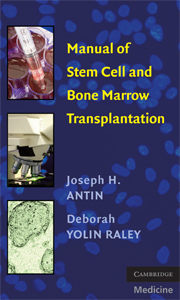Book contents
- Frontmatter
- Contents
- Acknowledgments
- Manual of Stem Cell and Bone Marrow Transplantation
- 1 Rationale for Transplantation
- 2 Types of Transplantation
- 3 HLA Matching in Allogeneic Transplantation
- 4 Stem Cell Source
- 5 Pretransplant Evaluation and Counseling of Patient and Donor
- 6 Conditioning Regimens
- 7 Stem Cell Infusion
- 8 ABO Compatibility
- 9 Engraftment
- 10 Preventative Care
- 11 Transplant-Related Complications
- 12 Graft-Versus-Host Disease – Prophylaxis and Acute
- 13 Graft-Versus-Host Disease – Chronic
- 14 Engraftment Syndrome
- 15 Infectious Disease
- 16 Graft Rejection And Failure
- 17 Gastrointestinal Complications
- 18 Pulmonary Complications
- 19 Veno-Occlusive Disease
- 20 Special Transfusion-Related Situations
- 21 Cardiovascular Complications
- 22 Neurologic Complications
- 23 Cystitis
- 24 Donor Lymphocyte Infusion
- 25 Transplantation: Regulation And Accreditation
- Appendix
- Index
18 - Pulmonary Complications
Published online by Cambridge University Press: 23 November 2009
- Frontmatter
- Contents
- Acknowledgments
- Manual of Stem Cell and Bone Marrow Transplantation
- 1 Rationale for Transplantation
- 2 Types of Transplantation
- 3 HLA Matching in Allogeneic Transplantation
- 4 Stem Cell Source
- 5 Pretransplant Evaluation and Counseling of Patient and Donor
- 6 Conditioning Regimens
- 7 Stem Cell Infusion
- 8 ABO Compatibility
- 9 Engraftment
- 10 Preventative Care
- 11 Transplant-Related Complications
- 12 Graft-Versus-Host Disease – Prophylaxis and Acute
- 13 Graft-Versus-Host Disease – Chronic
- 14 Engraftment Syndrome
- 15 Infectious Disease
- 16 Graft Rejection And Failure
- 17 Gastrointestinal Complications
- 18 Pulmonary Complications
- 19 Veno-Occlusive Disease
- 20 Special Transfusion-Related Situations
- 21 Cardiovascular Complications
- 22 Neurologic Complications
- 23 Cystitis
- 24 Donor Lymphocyte Infusion
- 25 Transplantation: Regulation And Accreditation
- Appendix
- Index
Summary
Pulmonary injury is one of the most common complications of stem cell transplantation and a major cause of morbidity and mortality. Damage to the lungs can be multifactorial, including infection, chemotherapy toxicity, graft-versus-host disease, radiation injury, hemorrhage, and immune reactions. Potential etiology can be determined by carefully considering timing of pulmonary complications and if the radiographic studies are focal or diffuse. Important to consider is history including exposures to infectious agents, current and recent prophylaxis regimen, cytomegalovirus status of patient and donor, prior treatment and exposure to pulmonary/cardiotoxic therapy and current and recent immunosuppression thearpy.
All patients should have baseline pulmonary function tests (PFTs) before transplantation, and aggressive diagnostic approach should be taken early after transplantation if there are pulmonary problems.
In general, patients with dyspnea and normal chest X-ray (CXR) should undergo PFTs and arterial blood gas analysis. Restrictive physiology should prompt a chest CT to look for interstitial disease. In patients who have normal PFTs and CXR, cardiac causes such as pulmonary hypertension and cardiac dysfunction should be excluded.
Bronchoscopy with bronchoalveolar lavage (BAL) should be performed early in the search for a diagnosis. If no diagnosis is made, lung biopsy if possible should be considered. Patients with focal infiltrates should be given empiric antibiotics plus or minus fungal therapy and assessed for a response before invasive measures are taken.
- Type
- Chapter
- Information
- Manual of Stem Cell and Bone Marrow Transplantation , pp. 130 - 138Publisher: Cambridge University PressPrint publication year: 2009



